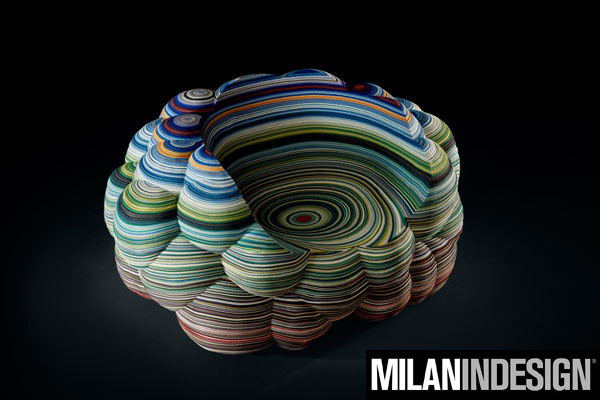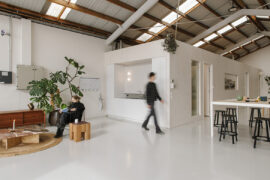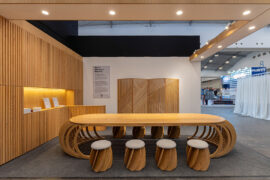A new Tokyo museum dedicated to the work of Katsushika Hokusai explores how to bring a soft touch to strict geometry.
Kazuyo Sejima, one half Pritzker prize-winning SANAA, has completed a new museum project In Tokyo’s Sumida Ward. The Sumida Hokusai Museum celebrates the life and work of acclaimed artist Katsushika Hokusai, and also stands as a conversation between design, culture, and the local community.
A monolithic block form the outside, Kazuyo Sejima’s five-storey museum is clad with a subtle reflective façade, which has the building showing a direct connection to its immediate cultural context.
What’s striking about the design philosophy of the Hokusai Museum is the manner in which it responds to the local scene it inhabits, while still recalling the imaginative flourishes of Hokusai’s artistic style. The exterior of the building is undoubtedly an eye-catching feature of it surrounds, but inside the palate is softer, the touch more delicate.
This juxtaposing approach is seen throughout the Sumida ward. Home to the iconic Tokyo Tower, and equally striking Asahi Beer Hall, this is a suburb of Tokyo where standing out is the name of the game. Yet like Japan itself, its futurist showmanship is always kept in check with a humanist approach to design, and to life. The striking nature of the Hokusai Museum is intended to catch the eye, yes, but it’s the ethereal forms and high level of refinement of the design that will keep the eye engaged. The angular structure encompasses and reflects Hokusai’s own woodblock paintings and his interest in oblique angles, his contrasting of the near and far, the manmade and natural.
Hokusai himself spent the majority of his artistic career at home in the Sumida Ward. To best reflect this, the Hokusai Museum offers up a map on their website that lets users explore local areas of interest, further tying to the design to the local history of the ward.
Throughout the building angular cuts into the reflective façade draw in natural light, allowing the works, including the iconic Great Wave Off Kanagawa, to be seen under changing and evolving conditions. This design evolution is paired by Sejima’s choice of angular geometries, and changing staircases of the interior of the museum.
Katsushika Hokusai is arguably the most famous ukiyo-e painter in history, and was born in 1760 and spent almost the whole 90 years of his life in Tokyo’s Sumida ward. The museum’s rotating collection will include a permanent showcases that examines the relationship between the artist and the region in which he lived. This exhibition ultimately becomes the an exploration of the museum itself, which too reflects the conversation between local region and creative ideas.
Photography by Vincent Hecht
INDESIGN is on instagram
Follow @indesignlive
A searchable and comprehensive guide for specifying leading products and their suppliers
Keep up to date with the latest and greatest from our industry BFF's!

For Aidan Mawhinney, the secret ingredient to Living Edge’s success “comes down to people, product and place.” As the brand celebrates a significant 25-year milestone, it’s that commitment to authentic, sustainable design – and the people behind it all – that continues to anchor its legacy.

For those who appreciate form as much as function, Gaggenau’s latest induction innovation delivers sculpted precision and effortless flexibility, disappearing seamlessly into the surface when not in use.

London-based design duo Raw Edges have joined forces with Established & Sons and Tongue & Groove to introduce Wall to Wall – a hand-stained, “living collection” that transforms parquet flooring into a canvas of colour, pattern, and possibility.
Winners of the North Queensland Regional Architecture Awards 2011 have been announced.

At Milan Design Week 2014, 22 designers created one-of-a-kind objects using Kvadrat’s Divina fabric, with some very colourful results.
The internet never sleeps! Here's the stuff you might have missed

Kiri Morgan, Director at Nightworks Studio, talks to us about the New Zealand practice’s very own new production space at Lawson St.

The final instalment in our three-part series on collaborations between the world’s best designers and the American Hardwood Export Council.

It’s designed for how you live, not just for how it looks.

The Fisher and Paykel Melbourne Experience Centre by Clare Cousins Architects with Fisher and Paykel Design and Alt Group has been awarded The Retail Space at the INDE.Awards 2025. As a winning project, it redefines the possibilities of retail architecture by creating an immersive, material rich environment shaped by place, culture and craft.